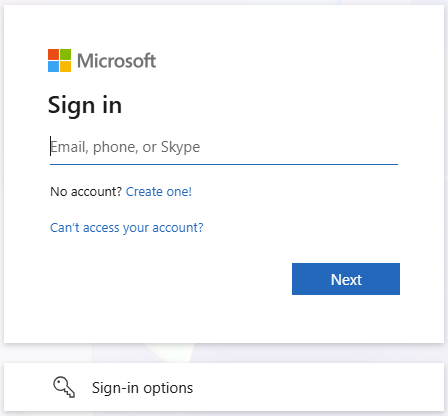Last updated 2025-10-09
If you have been licensed for Microsoft 365/SharePoint Online at Boston University, carefully follow the steps below to log in.
- If this is your first time logging in to Microsoft 365/SharePoint Online at BU and you have trouble with one browser, try using different browsers and/or using a Private or Incognito window. Also, we recommend that you use a regular computer for your first login rather than a portable device or phone (e.g., don’t use an iOS device for your first login). In subsequent logins, after you’ve successfully initialized your account profile and BU OneDrive, you can use any device and browser, and you can start directly at the URL for any SharePoint site to which you have been given access. Go first to https://portal.office.com/.
- You should see a login prompt similar to the one pictured below.

- At the prompt shown above, enter login@bu.edu, replacing login with your BU login name. Use the full form of your login name each time you enter it — don’t omit the “@bu.edu” part. Then click on Next.
- If you see a page asking whether you want to use your “Work or school account” or a “Personal account”, be sure to click on “Work or school account”.
- On the next page, you will be asked to enter your password — use your regular BU password. Then click on Sign in. You may be redirected to DUO for two-factor authentication. Once you have completed DUO verification, you should be logged in to BU’s Microsoft 365 tenant.
- Click on the Apps button on the left side. If this is your first time logging in, to ensure that your BU OneDrive is successfully created click on the OneDrive tile. (You can also just go to https://portal.office.com/onedrive). Otherwise, click on either the OneDrive or SharePoint tile to go to your desired destination. If you don’t see either of these, click on All apps to see a list of all your apps.
- If you were given a URL for a specific SharePoint site, you can now enter that to go directly to the site. In subsequent logins, you can use any browser and start just by entering that URL; you will be prompted to authenticate as above, then taken directly to the site you specified.
Having trouble?
- For your first login, use a regular computer for your first login rather than a portable device or phone (e.g., don’t use an iOS device for your first login). While you should be able to use any browser for most common functions in Microsoft 365, there are some exceptions. As a general rule, it’s always a good idea to try a different browser and even a different computer if you’re having trouble. If you are a SharePoint site administrator, you may also find that Edge works best on some administrative menus.
- You should not need to use Boston University’s Virtual Private Network (VPN) in conjunction with Microsoft 365 when connecting from outside the campus network. However, we have seen a few cases where a individual’s router firmware was not up to date and connecting through the VPN resolved the issue. If you’re off campus and having trouble (e.g., if the bar at the top of the page doesn’t display correctly), it’s worth trying the VPN to see if that resolves your issue.
Do you use an account in another Microsoft 365 tenant, e.g., at another school or workplace?
- If you are using Microsoft 365 in more than one tenant, you must take special care to keep the logins completely separate. E.g., if you log in to your (non-BU) school or workplace tenant using Edge, you cannot use that same browser session to log in to BU’s tenant. You could use an “in-private” session of the same browser (Edge), or a different browser entirely to log into BU’s tenant.
- Some companies may configure employee computers to automate your login to their tenant or to keep you logged in. If that’s the case, you might not even get the chance NOT to log in to that tenant from a computer configured by the company. In that case, try using a computer that the company hasn’t configured.
